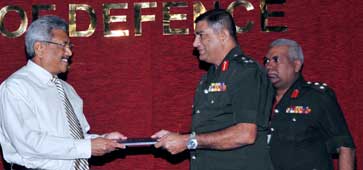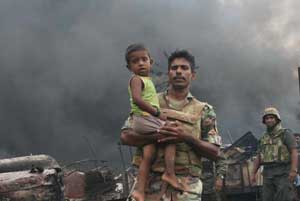Reply To:
Name - Reply Comment
Last Updated : 2024-05-06 22:48:00
.jpg) Observations, recommendations, and action plan for measures to safeguard civilians and avoid civilian casualties.
Observations, recommendations, and action plan for measures to safeguard civilians and avoid civilian casualties. The Commission stresses that there is a duty on the part of the State to ascertain more fully, the circumstances under which such incidents could have occurred, and if such investigations disclose wrongful conduct, to prosecute and punish the wrongdoers.
The Commission stresses that there is a duty on the part of the State to ascertain more fully, the circumstances under which such incidents could have occurred, and if such investigations disclose wrongful conduct, to prosecute and punish the wrongdoers..jpg) Thus the Commission’s task of reaching a definite conclusion as to who was responsible for the shelling of hospitals and loss of lives / damage to property is made extremely difficult by the non - availability of primary evidence of a technical nature and also the fact that supportive civilian evidence is equivocal in nature and does not warrant a definitive conclusion that one party or the other was responsible for the shelling.
Thus the Commission’s task of reaching a definite conclusion as to who was responsible for the shelling of hospitals and loss of lives / damage to property is made extremely difficult by the non - availability of primary evidence of a technical nature and also the fact that supportive civilian evidence is equivocal in nature and does not warrant a definitive conclusion that one party or the other was responsible for the shelling. These complex issues of contemporary relevance to the application of IHL must engage the immediate attention of the international community of States and relevant international organisations such as the UN and the ICRC, so that appropriate legal instruments are put in place to fill the existing lacunae in IHL in its application to internal conflicts.
These complex issues of contemporary relevance to the application of IHL must engage the immediate attention of the international community of States and relevant international organisations such as the UN and the ICRC, so that appropriate legal instruments are put in place to fill the existing lacunae in IHL in its application to internal conflicts..jpg) The Commission wishes also to note however that someone had recorded otherwise produced these images and the video and made it available to the broadcaster concerned. One expert enlisted by the Commission observes that “The segments of the footage appear to have been recorded in a natural environment” and that some of the bodies of alleged victims show no artifacts of manipulation either physically or by digital means.
The Commission wishes also to note however that someone had recorded otherwise produced these images and the video and made it available to the broadcaster concerned. One expert enlisted by the Commission observes that “The segments of the footage appear to have been recorded in a natural environment” and that some of the bodies of alleged victims show no artifacts of manipulation either physically or by digital means. To enhance the present IHL/HR Law dissemination programmes to reach all members of the armed forces and to re-design the courses to cover basic,middle level and advanced training on IHL / HR with the help of International Organizations. The Board notes that so called civilian casualties are mainly consisted of LTTE cadres killed in combat, civilians killed by LTTE for political and other reasons and civilians killed by LTTE whilst attempting to flee LTTE held areas. However in the spirit of reconciliation, the board recommends that the Government should implement a system to compensate the next of kin of all those killed and injured in the entire Island irrespective of their ethnicities or political affiliations.
To enhance the present IHL/HR Law dissemination programmes to reach all members of the armed forces and to re-design the courses to cover basic,middle level and advanced training on IHL / HR with the help of International Organizations. The Board notes that so called civilian casualties are mainly consisted of LTTE cadres killed in combat, civilians killed by LTTE for political and other reasons and civilians killed by LTTE whilst attempting to flee LTTE held areas. However in the spirit of reconciliation, the board recommends that the Government should implement a system to compensate the next of kin of all those killed and injured in the entire Island irrespective of their ethnicities or political affiliations.
Add comment
Comments will be edited (grammar, spelling and slang) and authorized at the discretion of Daily Mirror online. The website also has the right not to publish selected comments.
Reply To:
Name - Reply Comment
US authorities are currently reviewing the manifest of every cargo aboard MV
On March 26, a couple arriving from Thailand was arrested with 88 live animal
According to villagers from Naula-Moragolla out of 105 families 80 can afford
Is the situation in Sri Lanka so grim that locals harbour hope that they coul
1 hours ago - 0 - 90